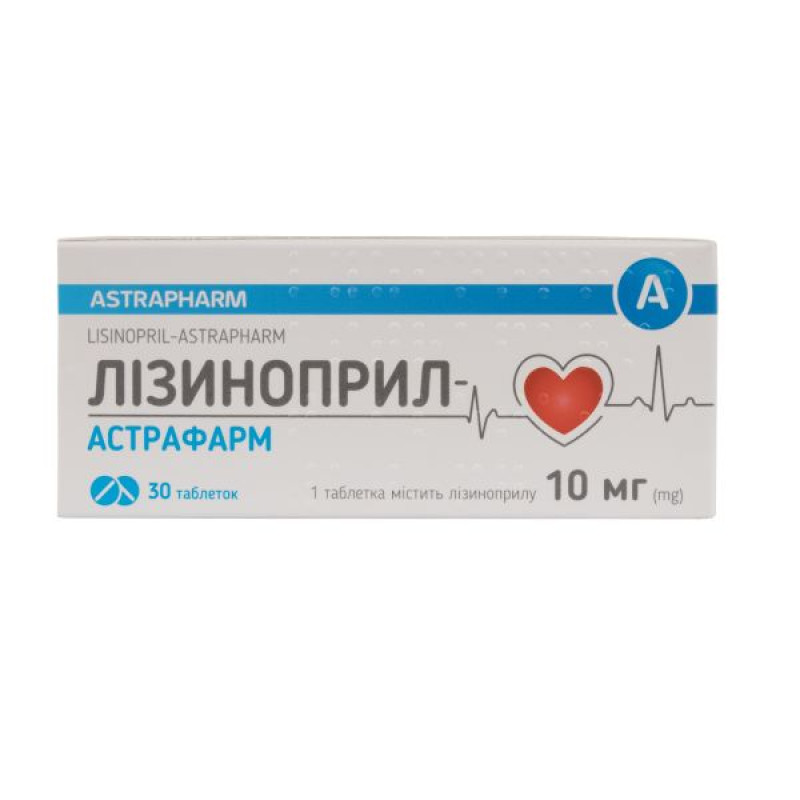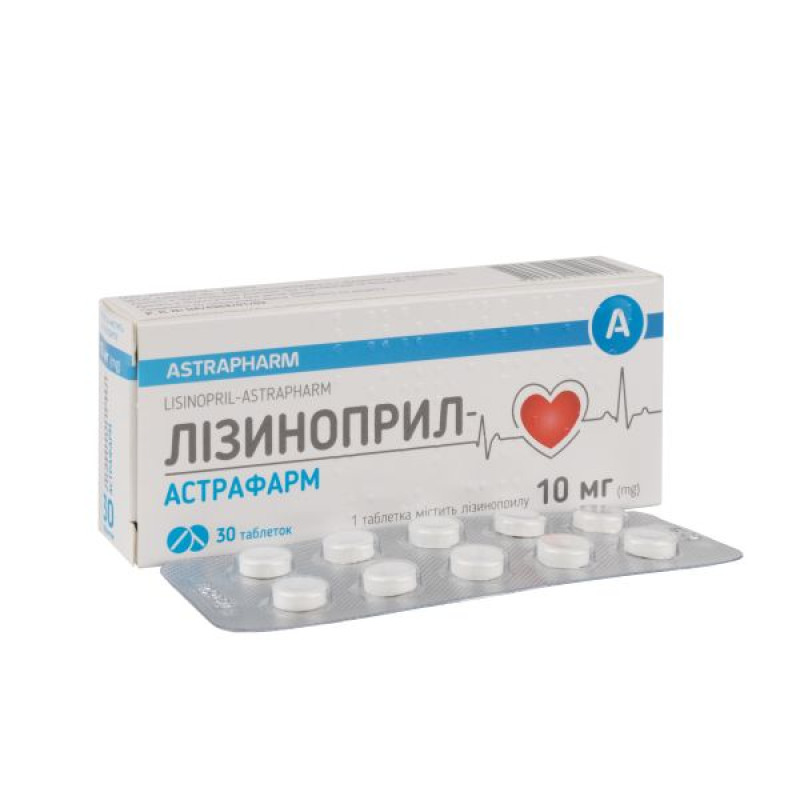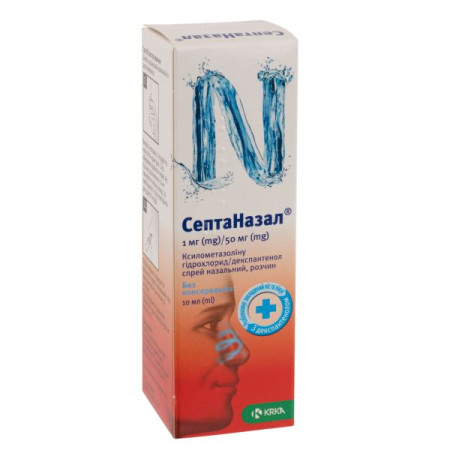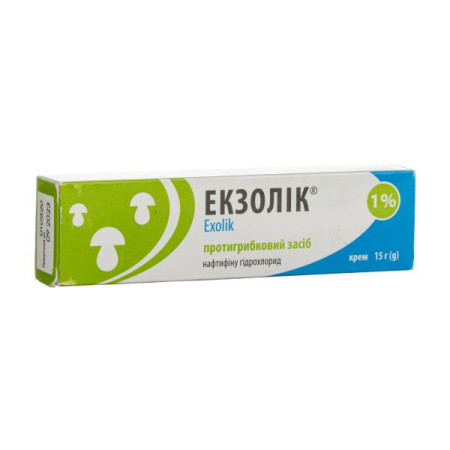Lisinopril tablets 10 mg blister No. 30
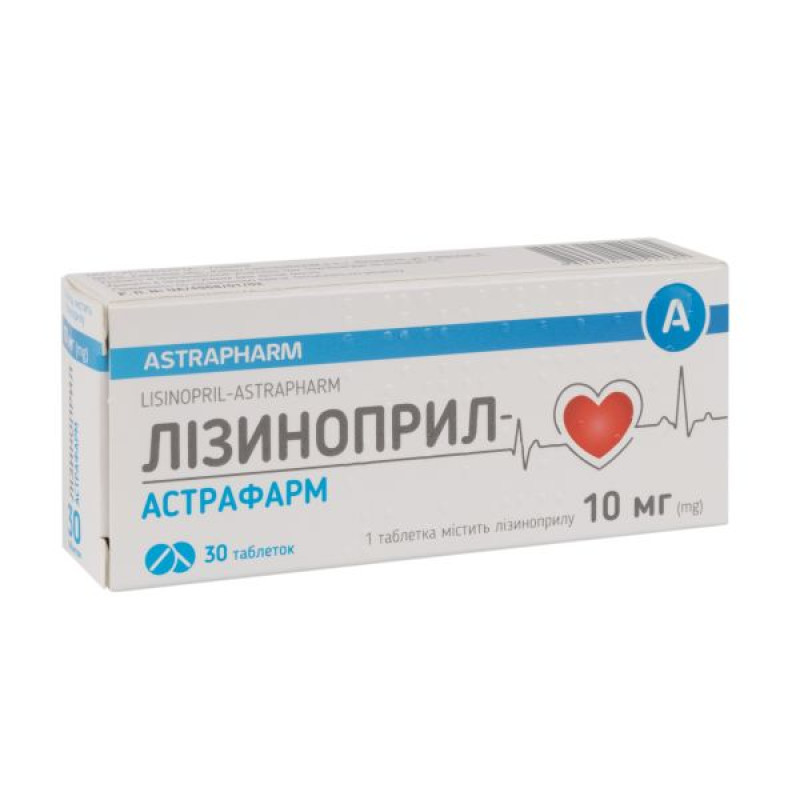
Instructions Lisinopril tablets 10 mg blister No. 30
Composition
active ingredient: lisinopril;
1 tablet contains lisinopril 5 mg or 10 mg or 20 mg;
excipients: calcium hydrogen phosphate, mannitol (E 421), corn starch, magnesium stearate, colloidal anhydrous silicon dioxide.
Dosage form
Pills.
Main physicochemical properties: white, flat-cylindrical tablets with beveled edges and a score.
Pharmacotherapeutic group
Angiotensin-converting enzyme (ACE) inhibitors. ATC code C09A A03.
Pharmacological properties
Pharmacodynamics
Lisinopril is an ACE inhibitor. ACE is a peptidyl dipeptidase that catalyzes the conversion of angiotensin I to the vasoconstrictor peptide, angiotensin II, which also stimulates aldosterone secretion. Inhibition of ACE results in a decrease in plasma angiotensin II concentrations, which leads to a decrease in vasopressor activity and aldosterone secretion. The latter decrease may lead to an increase in serum potassium concentrations.
Since the mechanism of action in hypertension is through inhibition of the renin-angiotensin-aldosterone system, lisinopril has a hypotensive effect even in hypertensive patients with low renin levels. ACE is identical to kininase, the enzyme that destroys bradykinin. The role of increased levels of bradykinin (which has pronounced vasodilating properties) during treatment with lisinopril is not fully understood and requires further study.
Pharmacokinetics
Absorption. After oral administration, lisinopril is slowly and incompletely absorbed from the gastrointestinal tract. Absorption of the drug after administration is approximately 25% with interindividual variability (6-60%). Simultaneous food intake does not affect absorption. Maximum plasma concentrations are reached after approximately 6-8 hours.
Distribution: Steady-state serum concentrations are reached within 2-3 days after administration. Except for ACE, it is not bound to plasma proteins.
Metabolism and excretion. Not metabolized, excreted in urine unchanged.
Removed by hemodialysis.
Pharmacokinetics in special patient groups.
In case of impaired renal function, the excretion of lisinopril is reduced in proportion to the degree of functional impairment (this reduction becomes clinically significant when glomerular filtration is below 30 ml/min).
In heart failure, renal clearance of lisinopril is reduced.
Elderly patients have higher plasma concentrations of lisinopril and area under the concentration-time curve (increased by approximately 60%) than younger patients.
Indication
Arterial hypertension.
Heart failure (symptomatic treatment).
Acute myocardial infarction (short-term treatment (6 weeks) of hemodynamically stable patients no later than 24 hours after acute myocardial infarction).
Renal complications in diabetes mellitus (treatment of kidney disease in hypertensive patients with type II diabetes mellitus and initial nephropathy).
Contraindication
Hypersensitivity to lisinopril, to other components of the drug or to other ACE inhibitors.
History of angioedema (including after use of ACE inhibitors, idiopathic and hereditary angioedema).
Aortic or mitral stenosis or hypertrophic cardiomyopathy with severe hemodynamic disturbances.
Bilateral renal artery stenosis or stenosis of the artery to a solitary kidney; acute myocardial infarction with unstable hemodynamics; cardiogenic shock; simultaneous use of the drug and high-flux membranes of polyacrylonitrile sodium-2-methylallylsulfonate (e.g. AN 96) in emergency dialysis; patients with serum creatinine levels ≥ 220 μmol/l.
Concomitant use of aliskiren-containing drugs in patients with diabetes mellitus or renal impairment (GFR < 60 ml/min/1.73 m2).
Primary hyperaldosteronism.
Pregnant women or women planning to become pregnant (see section “Use during pregnancy or breastfeeding”).
Concomitant use with sacubitril/valsartan: Treatment with Lisinopril-Astrapharm can only be started 36 hours after taking the last dose of sacubitril/valsartan (see sections “Interaction with other medicinal products and other types of interactions” and “Special precautions for use”).
Interaction with other medicinal products and other types of interactions
Medicinal products that increase the risk of angioedema. Concomitant use of ACE inhibitors with sacubitril/valsartan is contraindicated due to an increased risk of angioedema (see sections 4.3 and 4.4). Concomitant use of ACE inhibitors with racecadotril, mammalian target of rapamycin (mTOR) inhibitors (e.g. sirolimus, everolimus, temsirolimus) or vildagliptin may lead to an increased risk of angioedema (see section 4.4).
Potassium-sparing diuretics, potassium-containing dietary supplements, or salt substitutes. Although serum potassium levels in clinical trials with ACE inhibitors have generally remained within the normal range, some patients have developed hyperkalemia. The risk of hyperkalemia is associated with factors including renal insufficiency, diabetes mellitus, and concomitant use of potassium-sparing diuretics (e.g., spironolactone, triamterene, or amiloride) and potassium-containing dietary supplements or salt substitutes.
The use of potassium supplements, potassium-sparing diuretics or potassium-containing salt substitutes may lead to a significant increase in serum potassium, especially in patients with impaired renal function. When lisinopril is taken with potassium-sparing diuretics, hypokalemia caused by their use may be attenuated.
Caution should also be exercised when using Lisinopril-Astrafarm simultaneously with other drugs that increase serum potassium levels, such as trimethoprim and co-trimoxazole (trimethoprim/sulfamethoxazole), since trimethoprim is known to act as a potassium-sparing diuretic in the same way as amiloride. Therefore, the combination of Lisinopril-Astrafarm with the above-mentioned drugs is not recommended. If concomitant use of such drugs is indicated, treatment should be carried out with caution and serum potassium should be monitored frequently.
Cyclosporine: Concomitant use of ACE inhibitors with cyclosporine may cause hyperkalemia. Monitoring of serum potassium is recommended.
Heparin: Concomitant use of ACE inhibitors with heparin may lead to hyperkalemia. Monitoring of serum potassium is recommended.
Lithium. Concomitant administration of lithium and ACE inhibitors has been associated with a reversible increase in serum lithium levels and toxic effects. Thiazide diuretics may increase the risk of lithium toxicity and may exacerbate lithium toxicity already caused by concomitant ACE inhibitors. Concomitant use of lisinopril with lithium is not recommended, but careful monitoring of serum lithium levels is recommended if the combination proves necessary.
Nonsteroidal anti-inflammatory drugs (NSAIDs), including acetylsalicylic acid at a dose of ≥ 3 g per day. Long-term use of NSAIDs may reduce the hypotensive effect of ACE inhibitors. The effects of NSAIDs and ACE inhibitors on increasing serum potassium are additive, which may lead to impaired renal function. These effects are usually reversible. In isolated cases, acute renal failure may occur, especially in cases of impaired renal function, for example, in the elderly or in patients with dehydration.
Gold preparations: Nitritoid reactions (symptoms of vasodilation including flushing, nausea, dizziness, hypotension which may be very severe) following injection of gold (e.g. sodium aurothiomalate) have been reported more frequently in patients treated with an ACE inhibitor.
Other antihypertensive agents (β-blockers, α-blockers, calcium antagonists). When lisinopril is used concomitantly with other antihypertensive agents, an increase in the hypotensive effect is observed. Simultaneous administration of nitroglycerin and other organic nitrates or vasodilators may enhance the hypotensive effect of lisinopril.
Tricyclic antidepressants, anesthetics, and antipsychotics. Taking certain anesthetics, tricyclic antidepressants, and antipsychotics with ACE inhibitors may increase hypotension.
Sympathomimetic drugs: Sympathomimetic drugs may reduce the antihypertensive effect of ACE inhibitors. For this reason, the patient's blood pressure should be monitored more closely to determine whether the desired therapeutic effect has been achieved.
Hypoglycemic agents: Epidemiological studies have shown that concomitant administration of ACE inhibitors and hypoglycemic agents (insulins and oral hypoglycemic agents) may potentiate the effects of the latter, leading to hypoglycemia. The likelihood of such events is particularly high during the first weeks of concomitant treatment in patients and in patients with impaired renal function.
Dual blockade of the renin-angiotensin-aldosterone system (RAAS). It has been demonstrated that dual blockade of the RAAS with concomitant use of ACE inhibitors, angiotensin II receptor antagonists or aliskiren is characterized by a higher incidence of adverse reactions such as arterial hypotension, hyperglycemia, impaired renal function (including acute renal failure) compared with the use of monotherapy.
Allopurinol, cytostatics, immunosuppressants, corticosteroids, procainamide. When used simultaneously with lisinopril, they may cause leukopenia.
Drugs that suppress bone marrow function. When used simultaneously with lisinopril, the risk of neutropenia and/or agranulocytosis increases.
Estrogens. With simultaneous use of estrogens with lisinopril, a decrease in the hypotensive effect of lisinopril is possible due to fluid retention in the body.
Other
Lisinopril should be administered with caution to patients with acute myocardial infarction within 6–12 hours after the administration of streptokinase (risk of developing arterial hypotension).
Narcotics, anesthetics, alcoholic beverages, and sleeping pills in combination with lisinopril cause an increase in the hypotensive effect.
Application features
Symptomatic arterial hypotension.
Rarely observed in patients with uncomplicated arterial hypertension. In patients with arterial hypertension taking lisinopril, the likelihood of developing arterial hypotension increases with a decrease in circulating blood volume (for example, as a result of diuretic therapy, restriction of dietary salt intake, dialysis, diarrhea or vomiting), as well as in severe forms of renin-dependent arterial hypertension.
Symptomatic hypotension has been observed in patients with heart failure, whether or not associated with renal insufficiency. This is most often observed in patients with severe heart failure who are required to take large doses of loop diuretics and who have hyponatremia or functional renal insufficiency. Patients at increased risk of hypotension require careful observation during the initial period of treatment and during dose adjustment.
This also applies to patients with coronary heart disease or cerebrovascular disease, in whom a significant decrease in blood pressure can lead to myocardial infarction or cerebrovascular accident.
In case of hypotension, the patient should be placed on his back and, if necessary, intravenous sodium chloride solution should be administered. A transient hypotensive reaction is not a contraindication for the next dose of the drug. After restoration of the effective blood volume and the disappearance of the transient hypotensive reaction, treatment with lisinopril can be continued.
In some patients with chronic heart failure who have normal or low blood pressure, an additional decrease in systemic blood pressure may occur when lisinopril is prescribed. This effect is expected and is not usually a reason for discontinuation of therapy. If symptomatic hypotension occurs, it may be necessary to reduce the dose or discontinue lisinopril.
Hypotension in acute myocardial infarction. In acute myocardial infarction in hemodynamically stable patients, lisinopril should be administered within the first 24 hours to prevent left ventricular dysfunction and heart failure and to reduce mortality. In acute myocardial infarction, lisinopril should not be initiated if there is a risk of further serious hemodynamic deterioration following vasodilator treatment. This applies to patients with a systolic blood pressure of 100 mm Hg or less or patients who have developed cardiogenic shock. During the first 3 days after myocardial infarction, the dose should be reduced if the systolic blood pressure does not exceed 120 mm Hg. If the systolic blood pressure is equal to or below 100 mm Hg, the selected doses should be reduced to 5 mg or temporarily to 2.5 mg. If prolonged hypotension occurs after taking lisinopril (systolic blood pressure remains below 90 mm Hg for more than 1 hour), lisinopril treatment should be discontinued.
In patients with hypovolemia, sodium deficiency due to the use of diuretics, a salt-free diet, vomiting, diarrhea, after dialysis, sudden severe arterial hypotension, acute renal failure may develop. In such cases, it is advisable to compensate for fluid and salt losses before starting treatment with lisinopril and to ensure adequate medical supervision. With particular caution (taking into account the benefit/risk ratio) the drug should be prescribed to patients after kidney transplantation, as well as to patients with impaired renal function, liver, hematopoietic disorders, autoimmune diseases. All of the listed pathological conditions when using lisinopril require appropriate medical supervision and laboratory control.
As with other ACE inhibitors, lisinopril should be administered with caution to patients with mitral stenosis or left ventricular outflow obstruction (e.g., aortic stenosis or hypertrophic cardiomyopathy).
Kidney dysfunction.
In renal insufficiency (creatinine clearance < 80 ml/min), the initial dose of lisinopril should be determined based on the patient's creatinine clearance (see Table 1) and then based on the patient's response to treatment. Routine monitoring of potassium and creatinine is part of normal medical practice in these patients.
In patients with heart failure, deterioration of renal function may occur at the beginning of treatment with ACE inhibitors. In such situations, cases of acute renal failure, usually reversible, have been described. In some patients with stenosis of both renal arteries or stenosis of the artery to a solitary kidney, ACE inhibitors increase blood urea and serum creatinine; these changes usually resolve after discontinuation of the drug. This is especially likely in patients with renal failure.
In the presence of renovascular hypertension, there is a high risk of developing severe arterial hypotension and renal failure. In such patients, treatment should be initiated under close medical supervision with low doses that should be carefully titrated. Since diuretics may contribute to the clinical dynamics described above, they should be discontinued during the first weeks of treatment with lisinopril, and renal function should be closely monitored.
In some hypertensive patients without overt renal vascular disease, lisinopril, especially in combination with diuretics, has been associated with increases in blood urea and serum creatinine; these changes are usually minor and transient. They are more likely to occur in patients with impaired renal function. In such cases, it may be necessary to reduce the dose and discontinue the diuretic and lisinopril.
Treatment of acute myocardial infarction with lisinopril is not indicated in patients with evidence of renal dysfunction, as evidenced by serum creatinine >177 μmol/L and/or proteinuria >500 mg/day. If renal dysfunction develops during lisinopril therapy (serum creatinine >265 μmol/L or serum creatinine >200 μmol/L), the drug should be discontinued.
Hypersensitivity/angioedema. Angioedema of the face, extremities, lips, tongue, glottis and/or larynx has been reported very rarely in patients treated with ACE inhibitors, including lisinopril. Angioedema may occur at any time during treatment. In such cases, the drug should be discontinued immediately, appropriate therapy should be initiated, and the patient should be observed until symptoms resolve. Even in cases where the swelling is limited to the tongue and does not cause respiratory distress, the patient may require prolonged observation, as antihistamines and corticosteroids may be inadequate.
Isolated fatalities have been reported as a result of angioedema of the larynx or tongue. If the swelling extends to the tongue, glottis or larynx, obstructive respiratory failure may develop, particularly in patients who have previously undergone surgery on the respiratory tract. In such cases, emergency treatment should be initiated immediately, which may include the administration of adrenaline and/or the maintenance of a patent airway. The patient should be kept under close medical supervision until complete and sustained resolution of symptoms.
Patients with a history of angioedema unrelated to ACE inhibitor use may be at increased risk of developing angioedema in response to this class of drugs.
ACE inhibitors may cause more cases of angioedema in black patients than in white patients.
Concomitant use of ACE inhibitors with sacubitril/valsartan is contraindicated due to an increased risk of angioedema. Sacubitril/valsartan treatment should not be started until 36 hours after the last dose of Lisinopril-Astrafarm. Lisinopril-Astrafarm should not be started until 36 hours after the last dose of sacubitril/valsartan.
Concomitant use of ACE inhibitors with racecadotril, mTOR inhibitors (e.g. sirolimus, everolimus, temsirolimus) or vildagliptin may lead to an increased risk of angioedema (e.g. swelling of the airways or tongue with or without respiratory distress) (see section 4.5). Caution should be exercised when initiating racecadotril, mTOR inhibitors (e.g. sirolimus, everolimus, temsirolimus) and vildagliptin in patients already taking an ACE inhibitor.
When prescribing the drug in dialysis conditions with a polyacrylvinyl membrane, the development of anaphylactic reactions is possible. It is recommended to use membranes of a different type for dialysis or to use drugs of other groups for the treatment of patients with arterial hypertension.
Anaphylactoid reactions during LDL apheresis.
Since the use of ACE inhibitors during LDL apheresis with dextran sulfate can lead to the development of anaphylactic reactions, which can be life-threatening, ACE inhibitors should be temporarily discontinued before each apheresis.
Desensitization.
Patients receiving ACE inhibitors during desensitization therapy (e.g., to hymenoptera venom) have developed prolonged anaphylactoid reactions. When such patients were withheld from ACE inhibitors during desensitization, no reactions were observed, but accidental administration of ACE inhibitors has provoked anaphylactoid reactions.
Liver failure.
A rare syndrome that begins with cholestatic jaundice or hepatitis and progresses to fulminant hepatic necrosis, sometimes fatal, has been associated with the use of ACE inhibitors. The mechanism of this syndrome is unclear. If jaundice or significant elevations of liver enzymes occur in patients taking lisinopril, the drug should be discontinued and the patient should be monitored until symptoms resolve.
Neutropenia/agranulocytosis. Neutropenia/agranulocytosis, thrombocytopenia and anemia have been reported in patients receiving ACE inhibitors. Neutropenia is rare in patients with normal renal function and in the absence of other complicating factors. Neutropenia and agranulocytosis are reversible after discontinuation of the ACE inhibitor. Lisinopril should be used with extreme caution in patients with collagen vascular disease, immunosuppressive therapy, allopurinol or procainamide, or a combination of these complicating factors, especially in patients with impaired renal function. Some such patients develop serious infections that do not always respond to intensive antibiotic therapy. When using the drug in such patients, it is recommended to periodically monitor the number of white blood cells in the blood and instruct patients to report any signs of infection.
Cough. Cough may occur after the use of ACE inhibitors. The cough is usually non-productive and resolves after discontinuation of therapy. Cough caused by ACE inhibitors should be considered as a possible cause in the differential diagnosis of cough.
Surgery/Anesthesia: In patients undergoing surgery or anesthesia with agents that produce hypotension, lisinopril may block the formation of angiotensin II following compensatory renin secretion. If hypotension occurs due to this mechanism, volume expansion should be considered.
Serum potassium. There have been a few reports of increases in serum potassium in patients treated with ACE inhibitors, including lisinopril. Patients at high risk of developing hyperkalaemia include those with renal insufficiency, diabetes mellitus, and hypoaldosteronism. ACE inhibitors may cause hyperkalaemia because they inhibit the release of aldosterone. This effect is usually minor in patients with normal renal function. However, hyperkalaemia may occur in patients with impaired renal function and/or in patients taking potassium supplements (including salt substitutes), potassium-sparing diuretics, other medicinal products that increase serum potassium (e.g. heparin, trimethoprim or co-trimoxazole, also known as trimethoprim/sulfamethoxazole) and especially aldosterone antagonists or angiotensin receptor blockers. Potassium-sparing diuretics and angiotensin receptor blockers should be used with caution in patients receiving ACE inhibitors. Serum potassium and renal function should be monitored in such patients (see section 4.5).
If concomitant use of the above-mentioned drugs with lisinopril is considered appropriate, regular monitoring of serum potassium levels is recommended.
Hyperkalemia.
Some patients taking ACE inhibitors, including lisinopril, have experienced increases in serum potassium. Those at risk for hyperkalemia include patients with renal insufficiency or diabetes mellitus, those taking potassium-sparing diuretics or potassium-containing salt substitutes, and those taking other medicinal products that increase serum potassium (e.g. heparin).
If the use of the above drugs during treatment with an ACE inhibitor is deemed necessary, regular monitoring of serum potassium levels is recommended.
Patients with diabetes.
Diabetic patients taking hypoglycemic agents or insulin should have their blood glucose levels closely monitored during the first month of treatment with an ACE inhibitor.
Lithium.
Racial affiliation.
ACE inhibitors cause a higher incidence of angioedema in black patients than in non-blacks. As with other ACE inhibitors, lisinopril may be less effective in lowering blood pressure in black patients than in non-blacks, possibly because of a higher prevalence of low-renin states in the black hypertensive population.
Primary hyperaldosteronism.
In patients suffering from primary aldosteronism, ACE inhibitors are ineffective, therefore the use of lisinopril is not recommended.
Double blockade of RAAS.
Concomitant use of ACE inhibitors, angiotensin II receptor blockers or aliskiren has been reported to increase the risk of hypotension, hyperkalaemia and renal impairment (including acute renal failure). Therefore, dual blockade of the RAAS through concomitant use of ACE inhibitors, angiotensin II receptor blockers or aliskiren is not recommended.
If dual blockade therapy is absolutely necessary, it should be carried out under specialist supervision and regular monitoring of renal function, electrolytes and blood pressure should be performed. The concomitant use of ACE inhibitors and angiotensin II receptor blockers is not recommended in patients with diabetic nephropathy.
Proteinuria: Isolated cases of proteinuria have been reported in patients, particularly with impaired renal function or after high doses of lisinopril. In the presence of clinically significant proteinuria (>1 g/day), lisinopril should be used only after careful consideration of the therapeutic benefit and potential risk, with close monitoring of clinical and biochemical parameters.
The drug contains mannitol, which may cause a mild laxative effect.
Use during pregnancy or breastfeeding
Pregnancy. The drug is contraindicated for use in pregnant women and women planning pregnancy. If pregnancy is confirmed during the use of this drug, its use should be discontinued immediately and, if necessary, replaced with another drug approved for use in pregnant women.
It is known that prolonged exposure to ACE inhibitors during the second and third trimesters of pregnancy induces fetotoxicity (decreased renal function, oligohydramnios, skull ossification retardation) and neonatal toxicity (renal failure, hypotension, hyperkalemia). In case of exposure to ACE inhibitors during the second trimester of pregnancy, it is recommended to monitor renal function and skull bone by ultrasound.
Infants whose mothers have taken lisinopril should be closely monitored for hypotension, oliguria, and hyperkalemia.
Breast-feeding: Because no information is available regarding the use of lisinopril during breast-feeding, lisinopril is not recommended and alternative treatments with better established safety profiles during breast-feeding are preferable, especially while nursing a newborn or preterm infant.
Ability to influence reaction speed when driving vehicles or other mechanisms
Due to the possibility of dizziness and fatigue, lisinopril may affect the ability to drive and use machines, especially at the beginning of treatment. Therefore, driving and using machines should be avoided until individual response to the drug is established.
Method of administration and doses
Tablets are taken orally once a day, preferably at the same time, regardless of meals. The daily dose is selected individually depending on the patient's response and blood pressure indicators.
Arterial hypertension.
The drug is used as monotherapy or in combination with other classes of antihypertensive agents.
Initial dose.
In hypertension, the recommended starting dose is 10 mg per day. In patients with an overactive renin-angiotensin-aldosterone system (including renovascular hypertension, excessive sodium loss and/or dehydration, cardiac decompensation, or severe hypertension), an excessive decrease in blood pressure may occur after the initial dose. In these patients, the recommended starting dose is 2.5-5 mg and treatment should be initiated under medical supervision.
To obtain a dose of 2.5 mg, use a drug with the appropriate active ingredient content.
For patients with renal insufficiency, the dose should be reduced (see Table 1).
Maintenance dose.
The usual effective maintenance dose is 20 mg once daily. If the drug at this dose does not provide the desired therapeutic effect within 2-4 weeks, the dose can be further increased. The maximum daily dose is 80 mg per day.
In patients who are already receiving diuretic therapy, symptomatic hypotension may occur after taking the first dose of lisinopril. Diuretic therapy should be discontinued 2-3 days before starting treatment with the drug. If it is not possible to discontinue diuretic therapy, lisinopril should be prescribed at an initial dose of 5 mg per day. Renal function and serum potassium should be monitored. The subsequent dose should be selected depending on blood pressure. If necessary, diuretic therapy can be resumed.
Patients with renal failure.
For patients with renal insufficiency, doses are determined based on creatinine clearance as shown in Table 1.
Table 1
| Creatinine clearance (mg/min) | Starting dose (mg/day) |
| < 10 (including patients on hemodialysis) | 2.5* |
| 10–30 | 2.5–5 |
| 31–80 | 5–10 |
* The dose and/or dosing regimen is determined based on blood pressure values. The dose may be increased to no more than 40 mg per day with blood pressure monitoring.
The maintenance dose depends on the clinical response and is selected with regular monitoring of kidney function, potassium and sodium concentrations in the blood.
Chronic heart failure.
In patients with symptomatic heart failure, lisinopril may be used as an adjunct to diuretics, digitalis, or beta-blockers. Lisinopril is prescribed at an initial dose of 2.5 mg/day under medical supervision to determine the initial effect on blood pressure. The dose should be increased by no more than 10 mg at intervals of at least 2 weeks to a maximum dose of 35 mg/day.
Dose determination should be based on clinical observation of each patient.
In patients at high risk of developing symptomatic arterial hypotension (with excessive excretion of sodium chloride from the body) with or without hyponatremia, with hypovolemia, as well as in patients receiving high doses of diuretics, the above-mentioned conditions must be compensated before starting treatment.
Acute myocardial infarction.
Patients should receive conventional standard therapy with thrombolytic drugs, acetylsalicylic acid, and β-blockers. Lisinopril is compatible with intravenous or transdermal nitroglycerin.
Initial dose (in the first 3 days after myocardial infarction).
Lisinopril therapy should be initiated within the first 24 hours of the onset of symptoms.
Therapy should not be initiated if systolic blood pressure is below 100 mm Hg. The first dose of lisinopril is 5 mg, after 24 hours a dose of 5 mg is again prescribed, then a dose of 10 mg is prescribed 1 time per day, and then the maintenance dose is 10 mg 1 time per day.
Patients with systolic blood pressure (120 mm Hg or lower) are prescribed a reduced dose of lisinopril – 2.5 mg – in the first 3 days after myocardial infarction.
In renal insufficiency (creatinine clearance < 80 ml/min), the initial dose of lisinopril should be adjusted depending on the patient's creatinine clearance (see Table 1).
Maintenance dose.
The maintenance dose is 10 mg once daily. If hypotension occurs (systolic blood pressure <100 mmHg), the maintenance dose of 5 mg should be temporarily reduced to 2.5 mg. If prolonged hypotension occurs (systolic blood pressure <90 mmHg for more than 1 hour), treatment should be discontinued.
Treatment should be continued for 6 weeks, after which the patient's condition should be re-evaluated. In patients who develop symptoms of heart failure, treatment with lisinopril should be continued.
Diabetic nephropathy.
In the treatment of hypertension in patients with type 2 diabetes mellitus and incipient nephropathy, the dose of lisinopril is 10 mg once daily. If necessary, the dose can be increased to 20 mg daily to achieve a sitting diastolic blood pressure of less than 90 mm Hg.
In renal insufficiency (creatinine clearance < 80 ml/min), the initial dose of the drug should be adjusted depending on the patient's creatinine clearance (see Table 1).
Elderly patients.
In clinical studies, there were no
There are no reviews for this product.
There are no reviews for this product, be the first to leave your review.
No questions about this product, be the first and ask your question.







